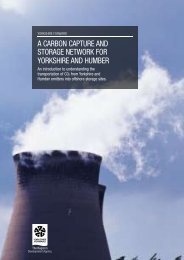Final report for One North East And NEPIC 21/12/10 - The Carbon ...
Final report for One North East And NEPIC 21/12/10 - The Carbon ...
Final report for One North East And NEPIC 21/12/10 - The Carbon ...
Create successful ePaper yourself
Turn your PDF publications into a flip-book with our unique Google optimized e-Paper software.
<strong>The</strong> case <strong>for</strong> a Tees CCS network<strong>Final</strong> ReportFigure 16 shows how a complex web of contractual arrangements needs to evolve in orderto consolidate and manage project risks arising between counterparties. <strong>The</strong> figure isillustrative only, and much simplified. As well as employing specific contractualagreements entered into between counterparties, the appropriate design of projectstructure and ownership arrangements will also serve to manage overall project risk byappropriately distributing risks - and potential rewards - between parties. Project structureand the choice of contractual arrangements are there<strong>for</strong>e necessarily interlinked. For thepurposes of illustration, just one simple model is shown - other options are possible andare discussed further in Section 6.<strong>The</strong> various risks and challenges associated with building and operating a network on acommercial basis do not require an evaluation based on some <strong>for</strong>m of risk „ranking‟; theyare so intimately connected, with potential impacts across many parties, that any onefailure in the chain could result in project failure. For example, network connectors cannotplan and invest in capture plant without the guarantee that sufficient network capacity willbe available (and under what terms) - similarly, investing in an oversized pipeline can onlybe justified where there are guarantees of sufficient utilisation. <strong>The</strong>re are similar mutualimpacts associated with the construction phase(s) of the network. This „project-on-project‟risk creates additional risk exposure issues between counterparties, and requiresadditional legal and commercial arrangements to manage exposure and insulatecounterparties to an acceptable level.<strong>The</strong>re<strong>for</strong>e, the principal aspect to resolve <strong>for</strong> the network promoter will be the securing ofnecessary up-front commitments or guarantees around the future usage of a scaled-upnetwork (e.g. long-term supply and off-take agreements). <strong>The</strong> need to address non-supplyand non-demand risk is there<strong>for</strong>e at the core of the contractual framework <strong>for</strong> a CCSnetwork. This issue is not uncommon in other projects based on investments requiringsuccessful multi- or bi-lateral commercial relationships. <strong>The</strong> use of long-term CO 2 supplyand off-take contracts between supply parties (i.e. by CO 2 capture entities and/or a midstreamnetwork operator), midstream operators (where these are separate to supplyparties) and demand parties (i.e. CO 2 storage and/or EOR operator(s)) which are mutuallyagreeable is there<strong>for</strong>e a key priority. As with natural gas pipelines, the commercialarrangements are likely to be based on the need to secure known capacity levels (i.e.capacity rights, capacity payments, with ability to re-sell capacity rights in a secondarymarket). Such contracts generally also contain penalty provisions and clauses addressingspecific concerns such as project failure or non-per<strong>for</strong>mance. Ultimately, it is this type ofnegotiated process, perhaps even involving bidding rounds or open-seasons <strong>for</strong> capacityrights, which will serve to determine the network capacity to be built at least in the firstphase. Our discussions with Teesside stakeholders suggest that nearly three-quarters ofthose spoken with would potentially be interested in considering entering into an initiallong-term supply contract <strong>for</strong> a Teesside network, either be<strong>for</strong>e 2020, or soon thereafter.<strong>The</strong> need to address „first of a kind‟ technology risk is also central to the success of thecontractual framework and commercial basis of the network. Per<strong>for</strong>mance guarantees <strong>for</strong>equipment must be provided be<strong>for</strong>e lenders can consider investing. Again, because of the„project-on-project‟ risk, these will be required across the entire system including eachplant, all the capture equipment and any new build plants (known as a “wrap”). Generalper<strong>for</strong>mance guarantees do not typically provide <strong>for</strong> the full range of technical risksassociated with operating the entire CCS network. For example, there will be concernsaround whether emitting plants can operate satisfactorily with the capture equipmentacross all operating modes, fuel input variations and exhaust gas streams, over their45







